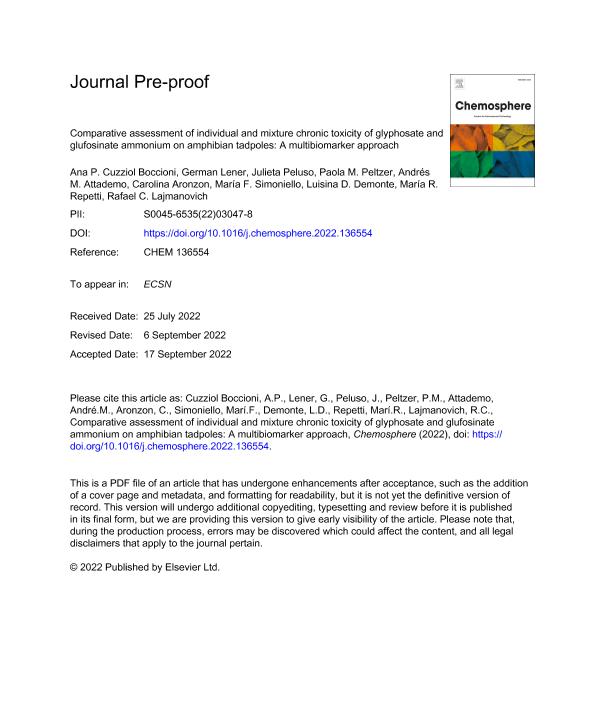Mostrar el registro sencillo del ítem
dc.contributor.author
Cuzziol Boccioni, Ana Paula

dc.contributor.author
Lener, German

dc.contributor.author
Peluso, Julieta

dc.contributor.author
Peltzer, Paola

dc.contributor.author
Attademo, Andres Maximiliano

dc.contributor.author
Aronzon, Carolina Mariel

dc.contributor.author
Simoniello, Maria Fernanda

dc.contributor.author
Demonte, Luisina Delma

dc.contributor.author
Repetti, María Rosa

dc.contributor.author
Lajmanovich, Rafael Carlos

dc.date.available
2024-04-04T11:49:58Z
dc.date.issued
2022-12
dc.identifier.citation
Cuzziol Boccioni, Ana Paula; Lener, German; Peluso, Julieta; Peltzer, Paola; Attademo, Andres Maximiliano; et al.; Comparative assessment of individual and mixture chronic toxicity of glyphosate and glufosinate ammonium on amphibian tadpoles: A multibiomarker approach; Pergamon-Elsevier Science Ltd; Chemosphere; 309; 12-2022; 1-12
dc.identifier.issn
0045-6535
dc.identifier.uri
http://hdl.handle.net/11336/231864
dc.description.abstract
The aim of the present study was to assess the ecotoxicity of glyphosate and glufosinate ammonium mixtures on amphibian tadpoles and the potential impact of mixture in aquatic ecosystems health. The bonding properties of the mixture based on computational chemistry and an experimental bioassay on morphology, DNA damage and biochemical biomarkers on tadpoles of the common toad Rhinella arenarum were studied. The results of the density functional theory analysis showed trends of the pesticides clustering to form exothermic mixtures, suggesting the likelihood of hot-spots of pesticides in real aquatic systems. In addition, biological effects of individual pesticides and the mixture were studied on tadpoles over 45 days-chronic bioassay. The bioassay consisted of four treatments: a negative control (CO), 2.5 mg L-1 of a glyphosate-based herbicide (GBH), 2.5 mg L-1 of a glufosinate ammonium-based herbicide (GABH) and their 50:50 (% v/v) mixture (GBH-GABH). Morphological abnormality rates were significantly higher in all herbicide treatments with respect to CO at 48 h of exposure. Abdominal edema was the most frequent type of abnormality recorded at 48 h, 10 and 45 days of exposure. DNA damage was recorded in all herbicides treatments. Thyroxin increased only in GABH treatment. Acetylcholinesterase (AChE) and butyrylcholinesterase (BChE) significantly increased in GBH treatment, indicating a GBH-neurotoxic effect. Glutathione S-transferase decreased in GABH and GBH-GABH treatments, while catalase decreased in individual GBH and GABH treatments. Overall, teratogenicity, DNA damage, hormonal disruption (T4), and oxidative stress were greater in GABH-treated tadpoles than GBH-treated tadpoles. This study also highlights the robust chemical interaction between the active ingredients of both herbicides, which is reflected on antagonisms in most of analyzed biomarkers, as well as potentiation and additivity in others. Based on our results, the GABH had a higher toxicity than GBH for amphibian tadpoles.
dc.format
application/pdf
dc.language.iso
eng
dc.publisher
Pergamon-Elsevier Science Ltd

dc.rights
info:eu-repo/semantics/openAccess
dc.rights.uri
https://creativecommons.org/licenses/by-nc-sa/2.5/ar/
dc.subject
ANURAN LARVAE
dc.subject
COMPUTATIONAL MODELING
dc.subject
DNA DAMAGE
dc.subject
ENZYMATIC ACTIVITY
dc.subject
HORMONAL DISRUPTION
dc.subject
MORPHOLOGICAL ABNORMALITIES
dc.subject.classification
Otras Ciencias Químicas

dc.subject.classification
Ciencias Químicas

dc.subject.classification
CIENCIAS NATURALES Y EXACTAS

dc.title
Comparative assessment of individual and mixture chronic toxicity of glyphosate and glufosinate ammonium on amphibian tadpoles: A multibiomarker approach
dc.type
info:eu-repo/semantics/article
dc.type
info:ar-repo/semantics/artículo
dc.type
info:eu-repo/semantics/publishedVersion
dc.date.updated
2023-07-07T17:20:09Z
dc.journal.volume
309
dc.journal.pagination
1-12
dc.journal.pais
Estados Unidos

dc.description.fil
Fil: Cuzziol Boccioni, Ana Paula. Universidad Nacional del Litoral. Facultad de Humanidades y Ciencias. Laboratorio de Ecotoxicologia; Argentina. Consejo Nacional de Investigaciones Científicas y Técnicas. Centro Científico Tecnológico Conicet - Santa Fe; Argentina
dc.description.fil
Fil: Lener, German. Universidad Nacional de Córdoba. Facultad de Cs.químicas. Departamento de Química Teórica y Computacional; Argentina. Consejo Nacional de Investigaciones Científicas y Técnicas. Centro Científico Tecnológico Conicet - Córdoba. Instituto de Investigaciones en Físico-química de Córdoba. Universidad Nacional de Córdoba. Facultad de Ciencias Químicas. Instituto de Investigaciones en Físico-química de Córdoba; Argentina
dc.description.fil
Fil: Peluso, Julieta. Universidad Nacional de San Martín. Instituto de Investigación e Ingeniería Ambiental. - Consejo Nacional de Investigaciones Científicas y Técnicas. Oficina de Coordinación Administrativa Parque Centenario. Instituto de Investigación e Ingeniería Ambiental; Argentina
dc.description.fil
Fil: Peltzer, Paola. Universidad Nacional del Litoral. Facultad de Humanidades y Ciencias. Laboratorio de Ecotoxicologia; Argentina. Consejo Nacional de Investigaciones Científicas y Técnicas. Centro Científico Tecnológico Conicet - Santa Fe; Argentina
dc.description.fil
Fil: Attademo, Andres Maximiliano. Universidad Nacional del Litoral. Facultad de Humanidades y Ciencias. Laboratorio de Ecotoxicologia; Argentina. Consejo Nacional de Investigaciones Científicas y Técnicas. Centro Científico Tecnológico Conicet - Santa Fe; Argentina
dc.description.fil
Fil: Aronzon, Carolina Mariel. Universidad Nacional de San Martín. Instituto de Investigación e Ingeniería Ambiental. - Consejo Nacional de Investigaciones Científicas y Técnicas. Oficina de Coordinación Administrativa Parque Centenario. Instituto de Investigación e Ingeniería Ambiental; Argentina
dc.description.fil
Fil: Simoniello, Maria Fernanda. Universidad Nacional del Litoral. Facultad de Bioquímica y Ciencias Biológicas. Cátedra de Toxicología y Bioquímica Legal; Argentina
dc.description.fil
Fil: Demonte, Luisina Delma. Universidad Nacional del Litoral. Facultad de Ingeniería Química. Programa de Investigación y Análisis de Residuos y Contaminantes Químicos; Argentina. Consejo Nacional de Investigaciones Científicas y Técnicas. Centro Científico Tecnológico Conicet - Santa Fe; Argentina
dc.description.fil
Fil: Repetti, María Rosa. Universidad Nacional del Litoral. Facultad de Ingeniería Química. Programa de Investigación y Análisis de Residuos y Contaminantes Químicos; Argentina
dc.description.fil
Fil: Lajmanovich, Rafael Carlos. Consejo Nacional de Investigaciones Científicas y Técnicas. Centro Científico Tecnológico Conicet - Santa Fe; Argentina. Universidad Nacional del Litoral. Facultad de Humanidades y Ciencias. Laboratorio de Ecotoxicologia; Argentina
dc.journal.title
Chemosphere

dc.relation.alternativeid
info:eu-repo/semantics/altIdentifier/url/https://linkinghub.elsevier.com/retrieve/pii/S0045653522030478
dc.relation.alternativeid
info:eu-repo/semantics/altIdentifier/doi/http://dx.doi.org/10.1016/j.chemosphere.2022.136554
Archivos asociados
